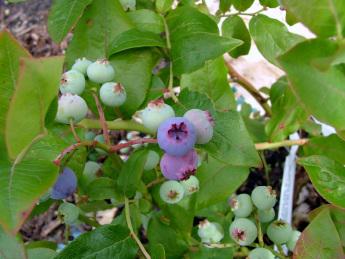those plant people
Fern Cottage
Vegetable garden
We are developing an annual vegetable garden from grazing land. Most of the land surrounding us is grazing for sheep or cows and one would not normally assume it suitable for vegetable production. We are testing out various permaculture techniques such as no-dig, different mulches and the use of polycultures, to observe which work for us and just how much effort is really required for the initial input. Where possible we will try and use reclaimed building materials.
Soft fruit
We hope to produce, for local sale, a range of jams, jellies, chutneys and other preserves from our newly planted soft fruit garden. In our walled garden we have planted a mixture of soft fruit, herbs and insect-loving plants. We could have included a mid-canopy layer of other fruiting trees, but as we need a commercially useful crop we felt it best to allow more light through, especially as the site is already shaded from other trees throughout the afternoon.

Orchard/Forest garden
The most sustainable way to grow food is using the forest garden model. Our pigs did a great job of clearing the land and manuring it ready to plant up in the winter of 2010/11. As an added bonus their efforts are still rewarding us, with a freezer full of sausages. We have grafted and planted various fruit trees such as apples, pears, quince, medlar and cherries onto a variety of rootstocks, some unusual. Between some of these we have planted nitrogen-fixing and nutrient accumulator plants such as Elaeagnus umbellata, various Alnus species and comfrey.
Also planted in this area are other fruit and nut shrubs such as Ribes (blackcurrants, red, white and pink currants, gooseberries and jostaberries), hazel, several Crataegus species, and a myriad of Rubus (raspberries, blackberries, loganberries, tayberries and the like), as well as many more unusual and ornamental yet still productive species. Below this shrubby layer we have sown a native wildflower and grass seed mix, including many to attract pollinating insects and to maximise biodiversity. We will also add various mints and strawberries to see which varieties can cope, tolerate and thrive in this very competitive layer.
Nursery
We propagate most of the plants we use in our designs, either from seed, cuttings, divisions or by grafting. We enjoy exploring the countryside throughout the year, seeking out new and tasty wild apples, pears and cherries probably originating from animal droppings or simply by people discarding cores and pips. We have collected scion wood and grafted the best of these to trial for usefulness. Seed was also collected from some currants, gooseberries and wild roses and we will select the most vigorous and disease-resistant plants.
The most sustainable way to grow food is using the forest garden model. Our pigs did a great job of clearing the land and manuring it ready to plant up in the winter of 2010/11. As an added bonus their efforts are still rewarding us, with a freezer full of sausages. We have grafted and planted various fruit trees such as apples, pears, quince, medlar and cherries onto a variety of rootstocks, some unusual. Between some of these we have planted nitrogen-fixing and nutrient accumulator plants such as Elaeagnus umbellata, various Alnus species and comfrey.
Also planted in this area are other fruit and nut shrubs such as Ribes (blackcurrants, red, white and pink currants, gooseberries and jostaberries), hazel, several Crataegus species, and a myriad of Rubus (raspberries, blackberries, loganberries, tayberries and the like), as well as many more unusual and ornamental yet still productive species. Below this shrubby layer we have sown a native wildflower and grass seed mix, including many to attract pollinating insects and to maximise biodiversity. We will also add various mints and strawberries to see which varieties can cope, tolerate and thrive in this very competitive layer.
Nursery
We propagate most of the plants we use in our designs, either from seed, cuttings, divisions or by grafting. We enjoy exploring the countryside throughout the year, seeking out new and tasty wild apples, pears and cherries probably originating from animal droppings or simply by people discarding cores and pips. We have collected scion wood and grafted the best of these to trial for usefulness. Seed was also collected from some currants, gooseberries and wild roses and we will select the most vigorous and disease-resistant plants.

